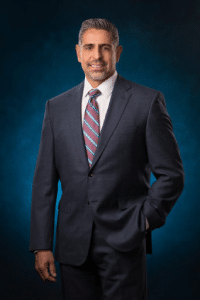Fractured Shoulder
What is a Broken Shoulder?
Trauma to the shoulder such as from a fall or sudden forceful impact can result in a fracture. A shoulder fracture can involve any one of three distinct bones in the shoulder joint which include:
- Collarbone- Clavicle fracture
- Upper arm bone- Humerus fracture
- Shoulder blade- Scapula fracture
What are the Common Types of Shoulder Fractures?
- Clavicle (collarbone) fractures are common in individuals of all ages and may result from a direct or indirect blow to the clavicle during a collision, automobile accident or fall onto an outstretched arm. Many patients may have a visible deformity, or bump at the fracture site.
- Humerus (upper arm bone) fracture can also occur from a fall or direct impact and is commonly seen in older patients with poor bone density due to osteoporosis. Humerus fractures can occur anywhere along the length of the bone but are most common to occur near the shoulder joint.
What are the Symptoms of a Shoulder Fracture?
- Significant pain
- Tenderness
- Bruising
- Swelling
- Weakness and inability to lift arm
How do you know if you have a Broken Shoulder?
Dr. Natividad will perform a complete physical examination of the injured shoulder with a series of x-rays. An MRI or CT scan may also be performed in more serious fracture cases to gain a better view of the fracture pattern and assess if the rotator cuff tendons have been injured.
Do you Need Surgery for a Fractured Shoulder?
This depends on many factors to include which bone is broken, if it is displaced or non-displaced, patients age, patients activity level and injury severity. Many humerus fractures may heal in approximately 3 – 4 months with non-surgical treatment. Dr. Natividad typically stabilizes the injured joint in a sling or similar device to immobilize the joint, allowing the bone to heal back together. Once the pain has subsided and the fracture has sufficiently healed, then a physical therapy program designed to help regain range of motion and strength is implemented.
How do you Treat a Fractured Shoulder with Surgery?
Some clavicle and humerus fractures are surgically treated if there is significant displacement (separation) between the bones and/or the patient is physically active and requires a faster recovery.
Surgical techniques designed to treat various types of shoulder fractures, including:
- Percutaneous pinning, which involves placing pins in the bones to secure them back in place.
- Open reduction internal fixation (ORIF), which involves opening up the fracture to realign the bones and stabilizing with the fracture with plate and screws.
- In some cases the severity of the fracture is significant and reconstruction with either a partial, total or reverse total shoulder replacement is appropriate and will be based on numerous factors.













